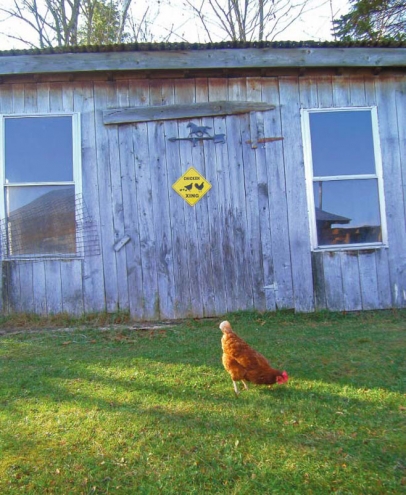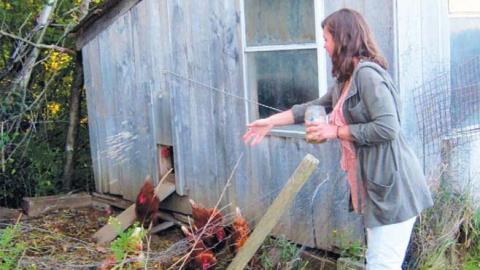Backyard Chickens Made Easy
Eight years ago, we got our first backyard hens from a family who wanted their lawn back. In one fell swoop we had a coop, waterer, feeder and five mature birds, so we didn’t have to make many decisions as we dove into the land of chickens. This was really great because we’d been considering getting hens for a while and the options were kind of overwhelming—what breed? What kind of coop? How much room should I have for a chicken run? Should we hatch chicks, or buy pullets?
As we’ve had to answer some of these questions over the years, one of our best resources has been word of mouth. So to put together this primer, I talked with my son, Francis, and some people at University of Vermont Extension. Amanda Gervais and Hannah Harwood work at UVM in crop and soils research. Gervais and her family run Savage Gardens in North Hero, growing vegetables and keeping 2,000 laying hens. Harwood is expanding her small flock of 11 hens this spring. Here’s some advice to help you get started.
BREEDS
In general, Gervais said, hens that lay green and brown eggs are very nice in temperament, while the breeds that lay white eggs tend to be very nervous. New Hampshire Red, Silver Wyandotte, Buff Orpington, Ameraucana and Auracana are all good choices.
My family has mostly had mutt birds we hatched from friends’ hens’ fertilized eggs, and we’ve been happy with both the animals and their eggs. But right now we have four Rhode Island Reds, and their uniformity is very appealing. I love looking at their creamy yellow legs and dark rusty feathers.
Another consideration is whether you want to eat your laying hens after they’ve finished their laying cycle. Full-grown hens can lay about 4–6 eggs a week for 2–3 years. The rate varies with nutrition, length of daylight and other factors. Barred Rocks and Red Rocks are both heavy breeds, which is good if you want a plump stewing hen.
Yet backyard hens might become pets instead of dinner, so bear that potential in mind. When we got hens we told our kids that we wouldn’t name them because they were eventually going to be dinner, and we were lucky that the boys just bought that line of thinking. If I had to do it again, I might be more open to whatever attachments might occur between kids and birds. Or, who knows, adults and birds.
SOURCES
Hatching chicks is really fun, but raising them is dusty business. Chicks kick up a storm from their feed, and that dust can really powder the place where they grow. Feed stores sell live chicks, and some farms do, too. You can also order them and get them shipped to you.
SPACE
Gervais said you need three square feet per bird in the coop itself. For a chicken run, you’ll need about 10 square feet per bird if you really want them to get enough to forage. “Any smaller than that, you just kind of make a dirt yard—and also, there’s not enough area for the hens to get away from manure,” she said.
To keep hens healthy, give them enough room indoors and out, and keep water and feed free from feces. An easy solution for the latter is to put the containers up on a slotted platform like a milk crate.
CHORES
Daily chores do not take much time. Morning and night, you need to open and close the coop door and do a headcount. Generally the birds go inside at dusk all by themselves. Collecting eggs and checking to make sure there’s enough water (a quart of fresh water per bird per day) and feed (the amount varies with how much foraging they do) might take 15 minutes a day, but usually less.
Quick daily checks of the hens’ eyes and combs tell a lot about their health. Clear eyes and bright combs are what you want. If you do get a sick bird, separate it from the flock—this is when we’ve called on farmer friends to suss out trouble. A few veterinarians look at chickens, and you can get a list from UVM of the ones that do. Seasonally, the coop will need cleaning. This might take a couple of hours, and you’ll want some place to compost the used bedding. Other irregular tasks are setting up fencing or netting to keep away hawks, foxes and other animals that want to harvest your birds. If you have enough room, you could occasionally move the run and coop— chicken tractors are a fun solution.
Mostly, hens don’t need a lot of your time, and the lure of fresh eggs is great payment for someone to help you take care of the hens when you go away for the weekend.
FEED
Chickens love leftovers. We give our chickens all our fruit and vegetable scraps, though some people avoid garlic and onions. If alliums do influence the flavor of eggs, we can never taste it. We also feed scrap bread from the bakery, and layer pellets from the feed store. In addition to bagged feed, Hannah Harwood sprouts wheat and feeds about a pound or two of sprouts a day to her hens. “They seem to like it a lot,” she said. “They gobble it up every morning. Their yolks seem really rich and bright, especially in the winter when they’re not getting grass.”
Those yolks might be the best ad for keeping chickens, but what the birds lend to family life is pretty great, too. Kids and chicks don’t just make nice portraits, but good relationships, too.








